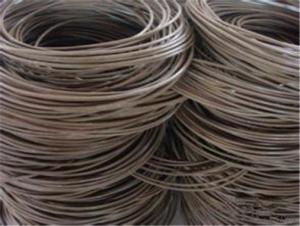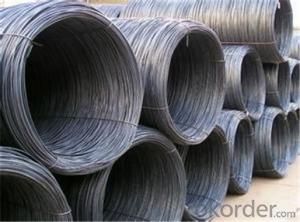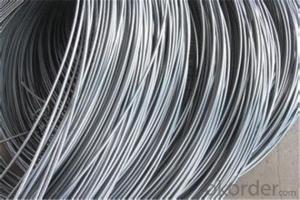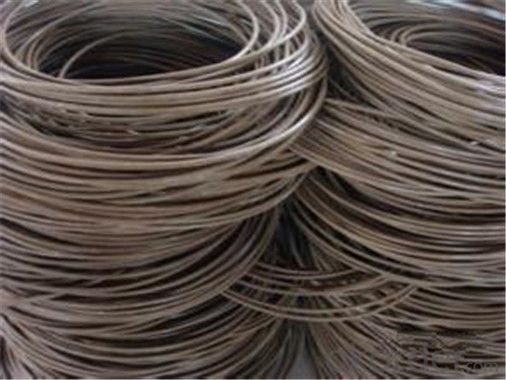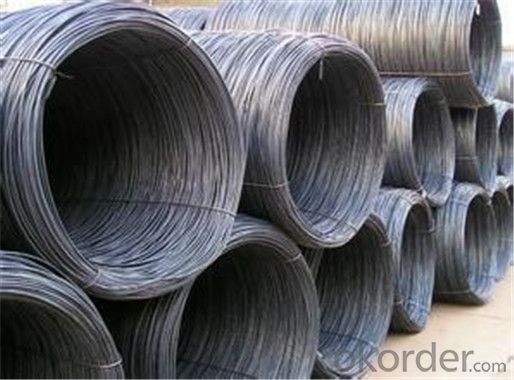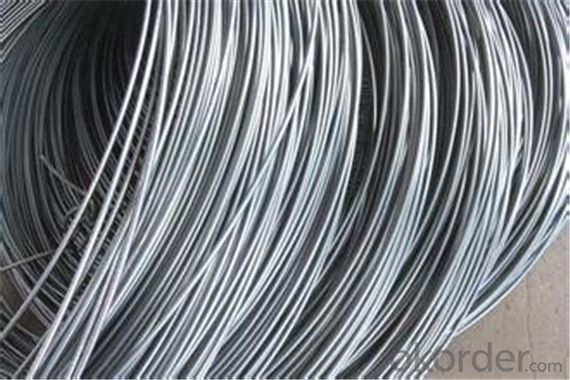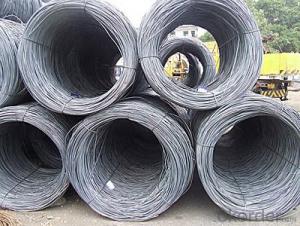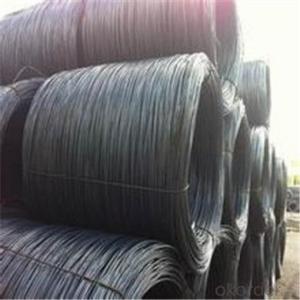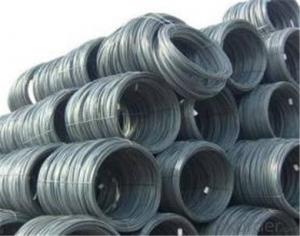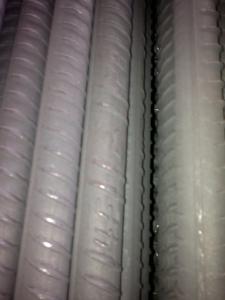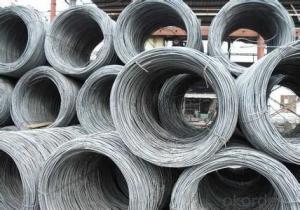Hot Rolled Steel Wire Rod 6.5mm with in China
- Loading Port:
- Shanghai
- Payment Terms:
- TT OR LC
- Min Order Qty:
- 500 m.t.
- Supply Capability:
- 45555555 m.t./month
OKorder Service Pledge
OKorder Financial Service
You Might Also Like
Specification
Description of wire Rod:
Diameter: 5.5mm,6.5mm,8mm,9mm,10mm,11mm,12mm
Grade:SAE1006/1008/1010/1012 /1015/1018
Coil weight:about 2 tons
Festures of wire Rod:
1. Drawn wire specialist, your wire rod solution
2. ISO9001 Certified Mill &SGS
3. Feature: machinability, high hardness, toughness, corrosion resistant
4. Customized service for your special requirement
5. Reasonable and more competitive mill price for you.
Specifications of wire Rod:
Product | steel wire rod |
Standard | AISI, ASTM, BS, DIN, GB, JIS |
Material/steel grade | Q195-Q235,SAE1006, SAE1008, SAE1010, SAE1018, SAE1020 or according to customers requirements |
Wire Gauge | 5.5-12mm |
Coil weight | 1.8-2.1mts |
MOQ | 25MT |
Delivery Time | 15-30 days after receipt of L/C or deposit by T/T |
Packing | In coil and load in container, if large quantity, by bulk vessel; Can be packed as customers' special requirements |
Payment terms | 1).100% irrevocable L/C at sight. |
Application | widely used in machinery parts |
Images of wire Rod:
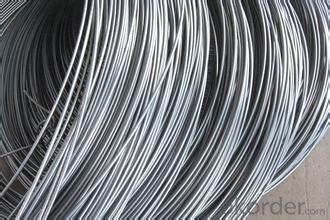
FAQ:
1. What is your package?
Packing situation: standard seaworthy packing or as customer required.
2. How long is the lead time?
Delivery time: 45 days after order confirmed.
- Q: How is steel wire rod used in the manufacturing of wire shelving?
- Steel wire rod is used in the manufacturing of wire shelving by being shaped and formed into the desired size and shape. It serves as the main structural component, providing strength and stability to the shelves. The wire rod is typically cut, bent, and welded to create the frame and supports of the shelving units, ensuring durability and the ability to hold heavy items.
- Q: What are the different ductility testing methods for steel wire rod?
- There are several different ductility testing methods for steel wire rods, including the tensile test, the bend test, and the wrap test. The tensile test measures the maximum amount of tensile force a wire rod can withstand before breaking, providing information about its elongation and ability to deform under tension. The bend test evaluates the wire rod's ability to withstand bending without fracturing, indicating its flexibility and resistance to brittleness. The wrap test assesses the wire rod's ability to wrap around a mandrel without cracking, giving insights into its ductility and ability to undergo plastic deformation. These testing methods collectively help determine the ductility and mechanical properties of steel wire rods.
- Q: What are the common production processes for krypton-coated steel wire rod?
- The common production processes for krypton-coated steel wire rod typically involve several stages. First, the steel wire rod undergoes surface preparation, which includes cleaning and degreasing to ensure proper adhesion of the krypton coating. Then, the wire rod is coated with a layer of krypton gas using a specialized coating equipment, such as a krypton gas chamber or a vacuum deposition system. This process allows the krypton atoms to adhere to the surface of the wire rod, creating a protective coating. Finally, the coated wire rod is subjected to curing or heat treatment to further enhance the adhesion and durability of the krypton coating. Overall, these processes ensure the production of high-quality krypton-coated steel wire rod with excellent corrosion resistance and other desirable properties.
- Q: What are the standard tolerances for steel wire rod diameter?
- The standard tolerances for steel wire rod diameter can vary depending on the specific industry and application requirements. However, there are generally accepted tolerances that are commonly used in the steel wire manufacturing industry. In general, the standard tolerances for steel wire rod diameter range from +/- 0.002 inches to +/- 0.010 inches. These tolerances ensure that the diameter of the wire rod falls within a specific range, allowing for variations in the manufacturing process while still meeting the required specifications. The specific tolerance range may be influenced by factors such as the intended use of the wire, the manufacturing process used, and the specific industry standards. For example, wire rods used in high precision applications, such as medical devices or aerospace components, may require tighter tolerances to ensure accuracy and reliability. It is important to note that these standard tolerances are subject to change based on the specific requirements of the customer or industry. Manufacturers often work closely with customers to determine the appropriate tolerances for their specific applications, taking into consideration factors such as the desired level of precision, the material properties of the wire rod, and any regulatory or industry standards that must be met. Overall, the standard tolerances for steel wire rod diameter provide a guideline for ensuring the dimensional accuracy and consistency of the wire rods, while allowing for reasonable variations during the manufacturing process.
- Q: How is steel wire rod used in the production of wire fencing?
- Steel wire rod is used as the primary material in the production of wire fencing. It is typically drawn through various dies to reduce its diameter and increase its strength, resulting in the creation of wire strands. These strands are then twisted or woven together to form the structure of the wire fencing. The steel wire rod provides durability, strength, and rigidity to the fencing, ensuring it can effectively contain livestock, secure property boundaries, or serve other protective purposes.
- Q: How is steel wire rod used in the manufacturing of wire for power transmission lines?
- Steel wire rod is a crucial component in the manufacturing of wire for power transmission lines. It is used as the raw material for producing the high-strength conductors that are responsible for carrying electrical energy over long distances. The manufacturing process begins with the selection of high-quality steel wire rods, which are typically made from carbon steel or alloy steel. These wire rods are then subjected to a series of processes such as heating, rolling, and drawing to transform them into wires with the desired diameter and strength. The steel wire rod's primary function is to provide the necessary mechanical strength and conductivity required for power transmission lines. Steel is known for its exceptional tensile strength, which allows the wire to withstand the immense tension and stress experienced during installation and operation of transmission lines. Additionally, steel wire rod offers excellent electrical conductivity, meaning it allows the efficient flow of electricity through the wire. This is crucial for minimizing power loss and ensuring optimal transmission efficiency over long distances. The manufactured wire made from steel wire rod is typically stranded together to form a conductor. Multiple layers of these steel wire strands are then wrapped around a central core to create a composite conductor. This design enhances the strength and flexibility of the wire, making it suitable for withstanding extreme weather conditions, wind, and ice loads. Furthermore, steel wire rod plays a crucial role in ensuring the longevity and reliability of power transmission lines. Its corrosion resistance properties protect the wire from environmental factors, such as moisture and chemical exposure, which could otherwise compromise the integrity of the line. In summary, steel wire rod is integral to the manufacturing of wire for power transmission lines due to its exceptional tensile strength, electrical conductivity, and corrosion resistance properties. It enables the production of high-quality conductors that can efficiently transmit electrical energy over long distances while withstanding various environmental challenges and ensuring uninterrupted power supply.
- Q: What are the different types of wire mesh for filtration made from steel wire rod?
- There are several types of wire mesh for filtration made from steel wire rod, including woven wire mesh, welded wire mesh, and expanded metal mesh. Each type has its own unique characteristics and applications in filtration systems.
- Q: How is the price of recycled steel wire rod determined?
- The price of recycled steel wire rod is determined through various factors such as the demand and supply dynamics in the market, the quality and grade of the recycled steel, the costs involved in the recycling process, and the prevailing market conditions. Additionally, factors such as global steel prices, raw material costs, and government policies also influence the price of recycled steel wire rod.
- Q: How are steel wire rods used in the manufacturing of wire baskets for storage?
- Steel wire rods are used in the manufacturing of wire baskets for storage by being shaped, cut, and welded to form the framework of the basket. These rods provide strength and durability to support the weight of items being stored, while also allowing for airflow and visibility.
- Q: What are the common applications of oil tempered steel wire rod?
- Oil tempered steel wire rod is a versatile material that finds numerous applications across various industries. Some of the common applications of oil tempered steel wire rod include: 1. Springs: Oil tempered steel wire rod is widely used in the manufacturing of springs, including automotive suspension springs, valve springs, and mechanical springs. Its high tensile strength, excellent fatigue resistance, and superior toughness make it an ideal material for these applications. 2. Cables and Wire Ropes: Oil tempered steel wire rod is used in the production of cables and wire ropes, which are extensively used in construction, mining, and transportation industries. Its high strength and flexibility make it suitable for heavy-duty lifting and pulling operations. 3. Automotive Industry: Oil tempered steel wire rod is utilized in various components of automobiles, such as seat frames, exhaust hangers, and brake springs. Its ability to withstand high temperatures and resistance to corrosion make it a preferred material in the automotive industry. 4. Construction Industry: Oil tempered steel wire rod is commonly used in the construction industry for applications like reinforcing concrete structures, manufacturing pre-stressed concrete products, and cable-stayed bridges. Its high tensile strength and durability ensure the integrity and longevity of the structures. 5. Furniture and Upholstery: Oil tempered steel wire rod is employed in the production of furniture and upholstery springs, providing comfort and support to sofas, chairs, and mattresses. Its ability to retain its shape and resistance to fatigue make it suitable for these applications. 6. Agricultural Equipment: Oil tempered steel wire rod is used in the manufacturing of various agricultural equipment, such as hay balers, fence wires, and vineyard trellising. Its strength, durability, and resistance to environmental factors make it ideal for these demanding applications. Overall, the common applications of oil tempered steel wire rod span a wide range of industries, thanks to its exceptional strength, durability, flexibility, and resistance to fatigue and corrosion. Its versatility and reliable performance make it a preferred choice for many critical applications.
Send your message to us
Hot Rolled Steel Wire Rod 6.5mm with in China
- Loading Port:
- Shanghai
- Payment Terms:
- TT OR LC
- Min Order Qty:
- 500 m.t.
- Supply Capability:
- 45555555 m.t./month
OKorder Service Pledge
OKorder Financial Service
Similar products
Hot products
Hot Searches
Related keywords
